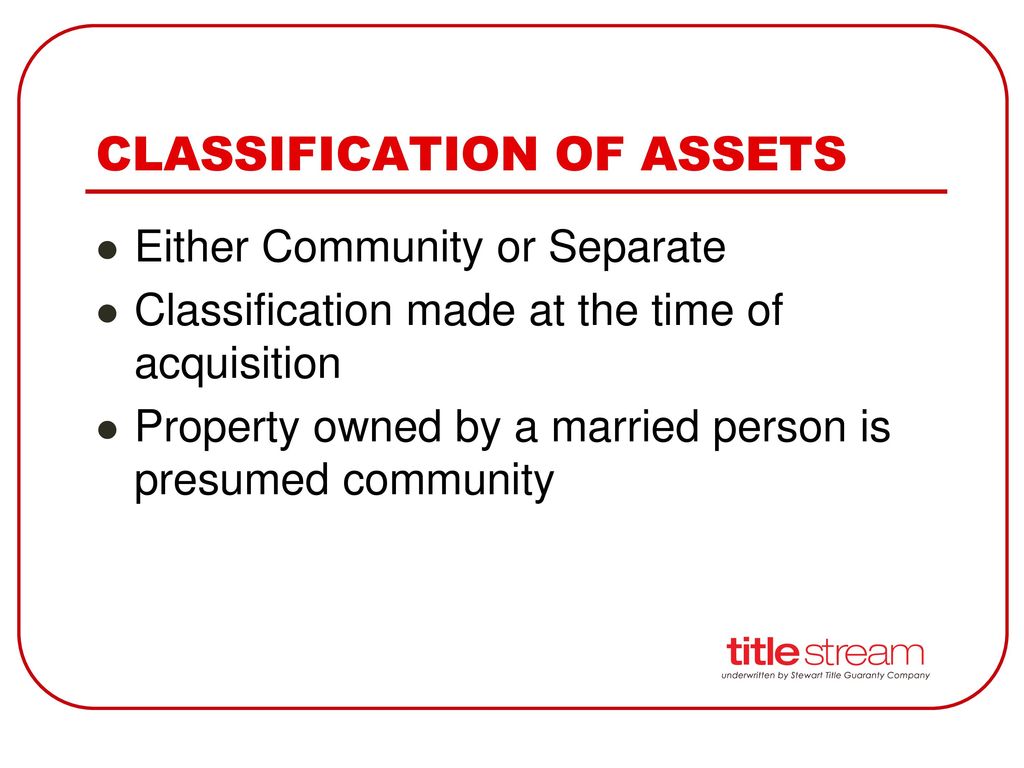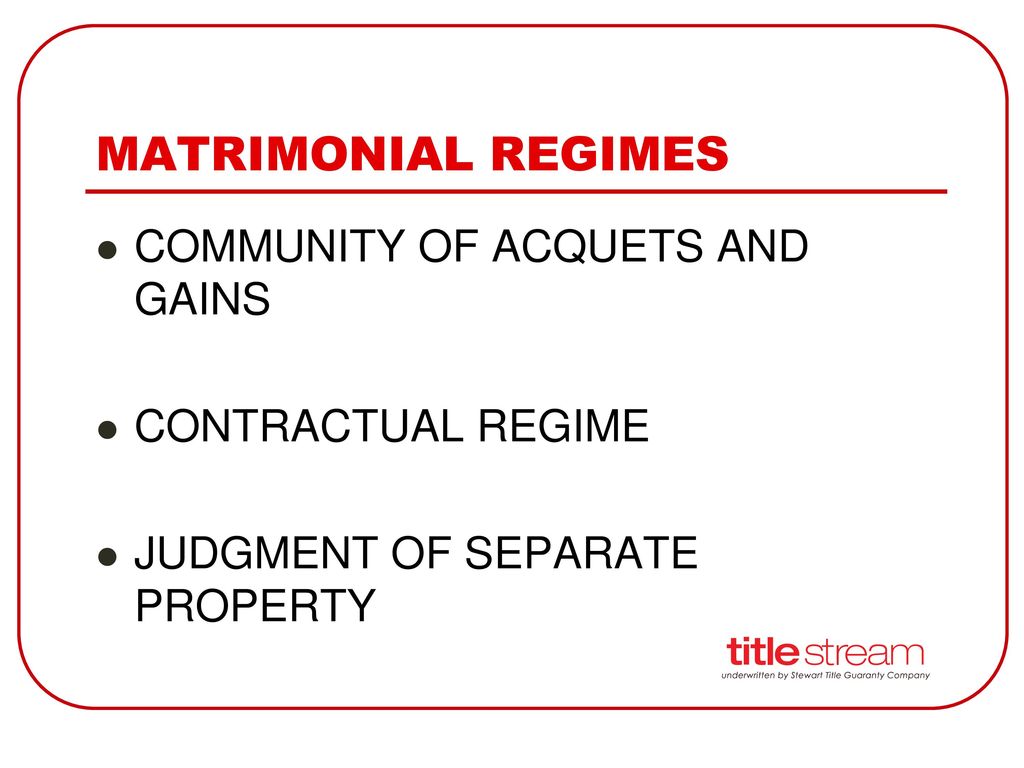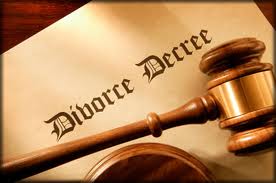Declaration of Paraphernality
Declarations of Paraphernality : Reserving Fruits and Revenues of Separate Property in Louisiana
Generally speaking, the law considers the fruits and revenues of separate property community property of a marriage. For example, the purchase of a rental property before marriage. The rent payments received during the marriage from that rental property would generally be considered community property. Even if the property itself is classified as separate property. In order to protect your property rights from becoming co-owned by your spouse in Louisiana you will need a Declaration of Paraphernality.
Fruits and revenues of separate property
The Louisiana civil code does allow an individual to reserve these revenues or “fruits” of separate property through a written declaration. We commonly call these instruments declarations of paraphernality. These contracts modify the matrimonial regime. When properly executed allow for the revenues and fruits of separate property to be classified as separate property. Louisiana Civil Code Article 2339, entitled “Fruits and revenues of separate property” provides:
“The natural and civil fruits of the separate property of a spouse, minerals produced from or attributable to a separate asset, and bonuses, delay rentals, royalties, and shut-in payments arising from mineral leases are community property. Nevertheless, a spouse may reserve them as his separate property as provided in this article.
A spouse may reserve them as his separate property by a declaration made in an authentic act or in an act under private signature duly acknowledged. The attorney will provide a copy of the declaration to the other spouse prior to filing.
Immovables
As to the fruits and revenues of immovables, the declaration is effective when a copy is provided to the other spouse and the declaration is filed for registry in the conveyance records of the parish in which the immovable property is located. As to the fruits of movables, the declaration is effective when a copy is provided to the other spouse and the declaration is filed for registry in the conveyance records of the parish in which the declarant is domiciled.”
It is of note that although the law doesn’t require the consent of the other spouse, the article states that the filing spouse must provide a copy of the declaration to the other spouse and be filed in the conveyance records of at least one parish. This article contains some very subtle complexities that have been the subject of debate in recent years. In order to execute an effective declaration under this article, contact an attorney.

Either Community or Separate. Classification made at the time of acquisition. Property owned by a married person is presumed community.
“Deborah Ann Plaisance LEVATINO
v.
Samuel Ray LEVATINO.” Levatino v. Levatino, 506 So.2d 858 (La. App. 1987)
This is a suit for declaratory judgment filed by Deborah Plaisance Levatino against her former husband, Samuel Levatino. Plaintiff seeks to have a piece of immovable property acquired during her marriage classified as community property. The defendant filed an exception of prescription which was sustained by the trial court and plaintiff now appeals.
Plaintiff and defendant were married on October 3, 1970. They did not enter into a separate property regime either before or during their marriage; thus, the community property regime applied. On July 31, 1980, they purchased a piece of immovable property with community funds. On November 6, 1980, plaintiff and defendant executed a declaration of paraphernality before a notary and two witnesses, which provided as follows:
This is to acknowledge that the property purchased is the separate property of Samuel Ray Levatino and was purchased with separate and paraphernal funds of Samual Ray Levatino and that Deborah Plaisance Levatino acknowledges this.
Plaintiff and defendant filed for legal separation on March 28, 1984. In the partition of the community, the defendant contended that this property was his separate property.
Plaintiff filed suit on July 23, 1984, seeking a declaratory judgment that the immovable property was community property. Plaintiff contended that the declaration of paraphernality should be set aside because she was induced to sign due to the fraudulent misrepresentations of defendant and due to the fact that she had no understanding of the document she signed.
Plaintiff further alleged that the declaration should be set aside because she received no consideration and because it was not executed before a notary and two witnesses.

JUDGMENT OF SEPARATE PROPERTY.
Defendant filed exceptions of no cause of action, no right of action, and prescription based on La.C.C. art. 2342. The court sustained the exceptions of no cause of action and no right of action and took the prescription exception under advisement. The court further ordered the plaintiff to amend her petition “to plead with specificity the facts constituting the purported fraud as alleged in her petition, failing which timely amendment, this suit shall be dismissed….”
Plaintiff amended her petition. Plaintiff alleged that she signed the declaration of paraphernality because the defendant represented to her that this document would shield her half of the community from any liability in connection with the debt owed on the property (both parties were liable on a $150,000 note).
Because both she and defendant were mistaken as to the effect of the document, plaintiff alleges there was mutual error which should invalidate it. Plaintiff then alleged that if it is shown that the defendant knew that his representation was false or if he intended to obtain an unjust advantage, the declaration should be set aside due to such artifice or deception.
Defendant filed a motion to dismiss for plaintiff’s failure to plead with specificity the facts constituting fraud. Meanwhile, the court overruled the earlier exception of prescription; the court reasoned that the prescriptive period of La.C.C. art. 2342 was not applicable to an action to set aside a declaration of paraphernality due to fraud nor was it applicable to an action between spouses where no third parties were involved. Defendant applied for writs which were denied by this court.
Plaintiff filed a motion for summary judgment supported by plaintiff’s affidavit and defendant’s deposition. The court assigned this motion for summary judgment for hearing along with the motion to dismiss. Following the hearing, the court took both matters under advisement.
Defendant then filed another exception of prescription. The court sustained the exception because “the reason for overruling the first exception of prescription no longer exists as the plaintiff in amending has failed to allege facts constituting fraud.”
Plaintiff appeals the trial court’s judgment sustaining the exception of prescription.
This court must now decide whether the prescriptive period of Article 2342 is applicable to plaintiff’s action to set aside the declaration of paraphernality due to error and/or fraud where the property has not been acquired by a third party. The facts are not at issue. The property was purchased with community funds during a marriage governed by the community property regime; plaintiff concurred in the declaration of paraphernality which was false.
Plaintiff and defendant executed the declaration in order to shield plaintiff’s half of the community from debt; the declaration did not and could not have done this since plaintiff was liable on the note. The husband actually did pay the note on the property, but such payment was made with community funds.

Plaintiff contends that La.C.C. art. 2342 is not applicable where there are allegations of fraud or error because these are recognized exceptions to estoppel by deed, the doctrine codified in La.C.C. art. 2342. Plaintiff further argues that the six month prescriptive period in La.C.C. art. 2342 was established to protect third parties as well as those adversely affected by transfers to third parties; plaintiff contends that she is not in either group.
Defendant agrees with the plaintiff’s contention that La.C.C. art. 2342 is not applicable where there is fraud; defendant then contends that plaintiff has abandoned her fraud claim. Defendant does contend that La.C.C. art. 2342 applies where there is error. Defendant also argues that La.C.C. art. 2342 would apply to an action between spouses who concurred in the declaration of paraphernality.
La.C.C. art. 2342 reads as follows:
A declaration in an act of acquisition that things are acquired with separate funds as the separate property of a spouse may be controverted by the other spouse unless he concurred in the act. It may also be controverted by the forced heirs and the creditors of the spouses, despite the concurrence by the other spouse.
Nevertheless, when there has been such a declaration, an alienation, encumbrance, or lease of the thing by onerous title may not be set aside on the ground of the falsity of the declaration.
The provision of this article that prohibits setting aside an alienation, encumbrance, or lease on the ground of the
Page 861
falsity of the declaration of separate property is hereby made retroactive to any such alienation, encumbrance, or lease prior to the effective date of this article.
A person who has a right to set aside such transaction on the ground of the falsity of the declaration, which right is not prescribed or otherwise extinguished or barred upon the effective date of this article, and who is adversely affected by the provisions of this article, shall have six months from the effective date of this article to initiate proceedings to set aside such transactions or otherwise be forever barred from exercising such right or cause of action.
Nothing contained in this article shall be construed to limit or prescribe any action or proceeding which may arise between spouses under the provisions of this article.
The prescriptive period as set forth in La.C.C. art. 2342 is six months from the effective date of the article. The article was effective on July 21, 1982; therefore, those persons affected by La.C.C. art. 2342 would have until January 21, 1983, to take action. In this case, the declaration was executed on November 6, 1980. Because plaintiff did not file suit until January 23, 1984, defendant contends that her suit is prescribed.
La.C.C. art. 2342 was enacted to codify the jurisprudential doctrine of estoppel by deed, which is that a declaration in an act of acquisition that things are acquired with separate funds as separate property of a spouse may not be controverted by the other spouse where he concurred in the act. Curtis v. Curtis, 403 So.2d 56, 59 (La.1981); Monk v. Monk, 243 La. 429, 144 So.2d 384 (1962).
Even where the spouse concurred in the act, the cases have recognized that he is not estopped from claiming the property is community property where he concurred due to fraud, error or duress. Rousseau v. Rousseau, 209 La. 428, 24 So.2d 676 (1946); Moore v. Moore, 187 So.2d 145 (La.App.2d Cir.), writ refused, 249 La. 451, 197 So.2d 438 (1966).
The initial provision of Art. 2342 was contained in Acts 1979, No. 709, Section 1, effective January 1, 1980, as follows:
A declaration in an act of acquisition that things are acquired with separate funds as separate property of a spouse may be controverted by the other spouse unless he concurs in the act. It may also be controverted by the forced heirs and the creditors of the spouses, despite the concurrence by the other spouse.
Nevertheless, when there has been such a declaration, a transfer of the thing by onerous title may not be set aside by a spouse, or by the creditors or forced heirs of the spouses.
Acts 1980, No. 565, Section 3, slightly modified La.C.C. art. 2342 to read as follows:
A declaration in an act of acquisition that things are acquired with separate funds as the separate property of a spouse may be controverted by the other spouse unless he concurred in the act. It may also be controverted by the forced heirs and the creditors of the spouses, despite the concurrence by the other spouse.
Nevertheless, when there has been such a declaration, an alienation, encumbrance, or lease of the thing by onerous title may not be set aside on the grounds of the falsity of the declaration.
The article was further amended by Acts 1982, No. 453, Section 1 to read as it presently does.
The first sentence of the article sets forth the doctrine of estoppel by deed; it does not set forth the jurisprudentially recognized exceptions to the doctrine. The second sentence gives the right to controvert a declaration of paraphernality to creditors, forced heirs, and non-concurring spouses. The second paragraph takes away that right where there has been “an alienation, encumbrance or lease of the thing by onerous title.
” Prior to the enactment of C.C. art. 2342, the declaration of paraphernality could be controverted even where the property had been acquired by a third party. In order to quiet title, the third party had to file suit to establish that the property was separate. Minden Chamber of Commerce, Inc. v. Goodman,
243 So.2d 843 (La.App. 2nd Cir.1971). Once C.C. art. 2342 was enacted, the right to controvert the declaration of separateness was lost where there was a transfer to a third party. The 1982 amendment made this provision of La.C.C. art. 2342 retroactive. Thus, third parties acquiring property prior to the enactment of La.C.C. art. 2342 no longer needed to file suit to establish that the property was separate, since no one could contest the separateness after January 21, 1983.
The wording of the sentence setting forth the prescriptive period is crucial. “A person who has a right to set aside such transactions on the ground of the falsity of the declaration … and who is adversely affected by the provisions of this article, shall have six months from the effective date of this article to initiate proceedings to set aside such transactions….” (Emphasis added). The six month prescriptive period is applicable to a cause of action to set aside those transactions as previously set forth in the article, which are alienations, encumbrances, or leases of the thing by onerous title.
The six month period is not applicable to a cause of action to controvert a declaration of separate property where there has been no onerous transaction. In the case before us, the plaintiff is not seeking to set aside a sale, lease or encumbrance, an action which would be governed by the six month prescriptive period; rather, the plaintiff is seeking to controvert a declaration of separateness where the acquiring spouse still has the property. This action is not governed by the six month prescriptive period.
Furthermore, the six month prescriptive period applies to those persons setting aside transactions due to the falsity of the declaration. In the case sub judice, plaintiff is not seeking to set aside the declaration based on its falsity alone; she is seeking to set it aside due to error and/or fraud, recognized exceptions to estoppel by deed, which therefore, should not be governed by any prescriptive period for estoppel by deed.
According to Spaht and Samuel, Equal Management Revisited: 1979 Legislative Modifications of the 1978 Matrimonial Regimes Law, 40 La.L.Rev. 83, 115-116 (1979), “[n]ever was it the intention of the Joint Legislature Subcommittee that this provision could be used by one spouse as an effective means of defrauding the other…. Presumably, the article will be interpreted as originally intended, that is, as a means of protecting innocent third persons who are not active or passive participants in interspousal fraud.”
Both the history and language of the article show that it was intended to protect innocent third parties who acquire property declared to be separate.
Defendant contends that a failure to apply the six month prescriptive period to the plaintiff would give her greater rights than a non-concurring spouse. This argument is without merit because Art. 2342’s prescriptive period only applies to an action to controvert the declaration of separate property where the property has been transferred to a third party through an onerous transaction.
In this case, had there been such a transfer through onerous transaction, any rights plaintiff possessed would have prescribed on January 21, 1983, just as would those of any non-concurring spouse, forced heir, or creditor.
Thus, the six month prescriptive period of La.C.C. art. 2342 is not applicable to this action because it is not one to set aside an alienation, encumbrance, or lease. Even if the six month prescriptive period were applicable to an action to controvert a declaration of separate property where no third parties are involved, it would not govern such an action where the basis for setting aside the declaration was fraud, error or duress, recognized exceptions to estoppel by deed.
In this case, the plaintiff’s allegations of fraud in her amended petition are that if it should be found that her former husband had the intent to deceive and that he was lying to gain an unfair advantage, she should not be estopped from controverting the declaration. The amended petition fails to comply with La.C.C.P. art. 856, requiring fraud to be pled with specificity. Plaintiff makes no factual allegations that would suggest fraud, even though prior to amending her petition, plaintiff deposed defendant.
None of the facts alleged by plaintiff amount to fraud as defined by La.C.C. art. 1953. “Fraud is a misrepresentation or a suppression of the truth made with the intention either to obtain an unjust advantage for one party or to cause a loss or inconvenience to the other.” La.C.C. art. 1953. Plaintiff was ordered by the court to amend her petition to plead facts constituting fraud; plaintiff, having failed to do so, abandoned her fraud claim and thus this exception to the estoppel by deed rule is not applicable.
Plaintiff’s amended petition does set forth facts which if proven would constitute error. Since error is an exception to the estoppel by deed rule, any prescriptive period applicable to estoppel by deed does not control. Because the six month prescriptive period of La.C.C. art. 2342 does not apply to actions to controvert declarations of separate property and because plaintiff’s action is based on mutual error, the controlling prescriptive period is the ten years as set forth in La.C.C. art. 3499.
For these reasons the judgment of the trial court sustaining the exception of prescription is reversed and the matter is remanded to the trial court for further proceedings. Cost of this appeal are to be borne by appellee, Samuel Ray Levatino.
REVERSED.
Levatino v. Levatino, 506 So.2d 858 (La. App. 1987)
This is a case about declaration of paraphernality and how declaration of paraphernality ‘s work in Louisiana. It is important to get an experience attorney that understands declaration of paraphernality an helps clients file for them during the marriage. Our office handles many types of declarations of paraphernality.
Contacting a Louisiana Separate Property Lawyer about a declaration of paraphernalit at the Weiser Law Firm today at 504-358-2273.
declaration of paraphernality declaration of paraphernality declaration of paraphernality declaration of paraphernality declaration of paraphernality declaration of paraphernality declaration of paraphernality declaration of paraphernality declaration of paraphernality declaration of paraphernality

Either Community or Separate. Classification made at the time of acquisition. Property owned by a married person is presumed community.
declaration of paraphernality declaration of paraphernality declaration of paraphernality declaration of paraphernality declaration of paraphernality declaration of paraphernality declaration of paraphernality declaration of paraphernality


